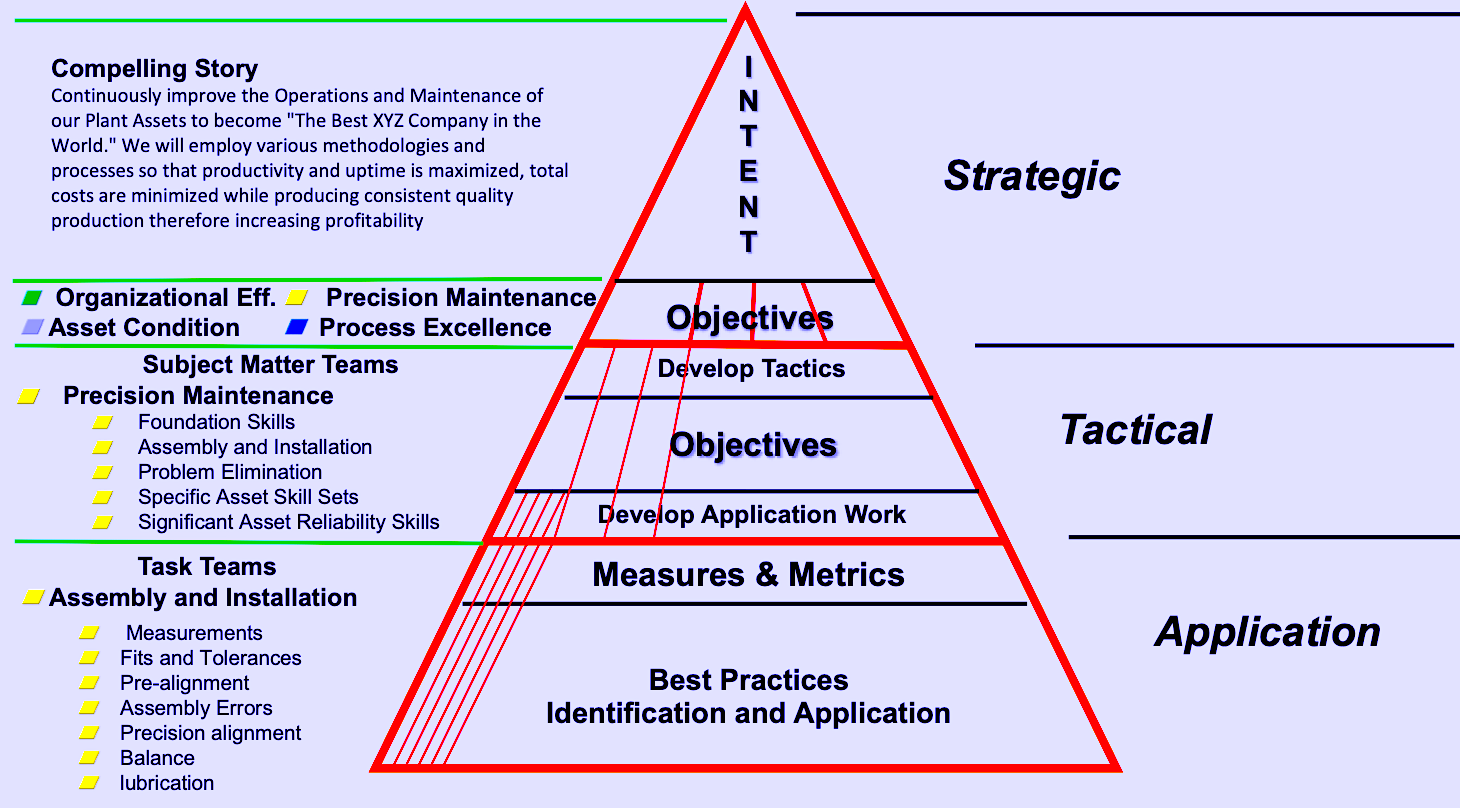In last week’s article, we took a quick look a what precision maintenance is and the four main steps for implementing it. Those steps include: 1) Creating the Strategy, 2) Building a Plan, 3) Applying the Work, and 4) Capturing Results. Here, we focus on the first of those steps.
“Creating the Strategy” begins when all interested parties and stakeholders sit down and answer the question, “What are we trying to achieve?”Based on the answer to that question, we can develop a “business intent statement.”
Note that I specifically stay away from the terms “mission statement” and “vision statement.” This is because, all too often, mission and vision statements contain wonderful prose, but don’t say anything concrete that ties employees to the intent.
To be effective, intent statements must not only set the overarching goal, but also directly connect the employees to it. As an example, consider this example:
“Our goal is to authoritatively disseminate highly efficient collaboration and idea-sharing, while continuing to completely foster client-centered ‘outside the box’ thinking while promoting personal employee growth.”
Sounds plausible right? Does it seem somewhat familiar? How, though, would an employee connect to that statement? (This was actually courtesy of the website www.joe-ks.com)
WRITING THE INTENT STATEMENT
The following example of an intent statement not only defines the ultimate goal but identifies the tactics to be used to get there.
“Continuously improve the Operations and Maintenance of our Plant Assets to become ‘The Best XYZ Company in the World.’ We will employ various methodologies and processes so that productivity and uptime is maximized and total costs are minimized, while producing consistent quality production therefore increasing profitability.”
Notice, in the above example, how each of the referenced tactics, i.e., methodologies, productivity and uptime, costs, quality, and profitability, are all measurable and, therefore, can be used to track progress and demonstrate the value of the work. (By the way, if this were your organization’s intent statement, and you weren’t working on those tactics, my answer would be that you were working on the wrong things.)
Remember: When developing an intent statement, it is important to include all interested parties as the WIIFM (“what’s in it for me”) will be different for the different disciplines in your facility.
TACTICAL AND APPLICATION MEASUREMENTS
Examples of tactical measurements might include precision attempts per month; machines in a precise state, power/carbon savings; average vibration level by area, etc.
Each of the tactical goals should then be broken down into the application work needed to support the tactic and, accordingly, the overarching strategy (see figure).

Relationship between strategic, tactical, and application metrics
Application-level metrics could include jobs with completed documentation, such where soft foot was checked and corrected and the percentage of fasteners tightened on a controlled manner. Application metrics are used to manage the day to day/week to week activities. Tactical metrics are, by their nature, slower-changing and longer-term, but all eventually support the overarching strategic goal.
Here are examples of metrics commonly applied to precision maintenance:
- Unscheduled Maintenance D/T/Wk. Frequently used as a tactical measurement as costs are relatively easy to calculate
- Top-40 Machine Vibration Trend (Down). Trend of the worst 40 (or 10) vibrating machines. Since we should be addressing these situations first, this is a good leading indicator of future direction.
- # of Machines Above 0.25ips. Similar to above.
- Plant-Wide Vibration Levels Trend Decreasing. More of a long-term strategic indicator that can be used to validate long-term progress.
- Power/Carbon Savings. Great short-term metric where we can assign value to and show improvement. Very important to gain buy-in during the initial phases.
Here are examples of leading indicators:
- PdM Route Compliance. Indicates we are at least doing inspections but be careful here unless we have some metrics around the quality of the inspections. (See sidebar below for a note of caution from the author regarding heavy reliance on compliance metrics.)
- Work Generated by PdM Activities. A good indicator of how effective PdM is. If +- 80% of failures are random then a significant amount of work should be driven by PdM up to +- 80%.
- Precision Attempts per Month. A good leading indicator.
- Machines in Precise State Per Month. Used in conjunction with the attempts per month can indicate how effective we are at precision maintenance.
- % of Outage Work Devoted to Asset Improvement Work. Another telling measurement of how much real precision work is going on. (Often, precision work can be the first to go when planning and scheduling go awry.)
Here are examples of traditional lagging indicators:
- MTBF (mean time between failure)
- MTTR (mean time to repair)
- Maintenance Costs (unit cost)
- Downtime/uptime/OEE etc.
- Spare Parts spend.
Once an organization has determined its strategic business intent, defined its expectations for precision maintenance, and identified defined the tactics and work to be done along with how to measure success, it’s ready to build the plan. We’ll focus on building the plan in next week’s article.TRR
Author’s Note Sidebar: Beware Heavy Reliance on Compliance Metrics
(Referenced Above in’PdM Route Compliance’ Example of A Leading Indicator)
I observed a problem with heavy reliance on compliance metrics at a facility a few years ago. Pursuit of schedule compliance was relentless for the PdM team, but no consideration was given to the quality of the work done. In an effort to attain full compliance under an increasing workload, it was determined that, to maintain the schedule, there would be a reduction in the number of measurements taken. This was accomplished by taking a vibration measurement at a single location on a machine (e.g., center of motor frame) rather than at the usual bearing locations. Success, at last! Almost immediately, the schedule was compliant. Within three months, however, several undetected bearing failures occurred. Yours truly was involved in the investigation afterwards. Moral of the story here is to be careful in what you measure: You might get it.
…Tim Dunton
ABOUT THE AUTHOR
Tim Dunton is the Director of Product Development and thought leader for Reliability Solutions, a UT-RMC training partner based in Northwest Florida. He has over 40 years of experience in vibration analysis and technical training related to the reliability of rotating machinery, including extensive work and qualifications in machinery troubleshooting, problem-solving, and condition-monitoring program design, implementation and operation. His background also includes significant experience in workforce development, curriculum development, instructional design, and Reliable Manufacturing. Dunton holds DTI Class 1 Certification, CMRP, and CMRT Certifications. Email: timdunton@reliabilitysolutions.net.
Tags: reliability, maintenance, availability, RAM, maintenance management, change management, workforce issues, skills development, training and qualification



